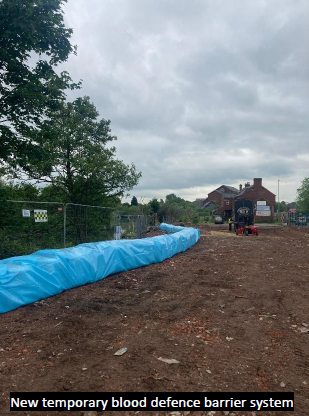Asbestos Removal, Demolition, Slab Removal and Crushing, Land Remediation & Landscaping
Savile Road, Castleford
Introduction:
The 0.5-acre site is located directly off Savile Road, within the centre of Castleford. There were 7 derelict properties located on the compact site, Wakefield Council decided the best course of action would be to demolish the buildings, to regenerate use of the land.
Ron Hull Demolition secured the work under competitive tender, the confidence and proven track record in delivering similar projects giving Wakefield Council the confidence to appoint us as principal contractor, following the tender process on a 30% price 70% quality basis.
The site was a complicated strip of land, with various constraints and environment issues to manage and factor into work planning:
*Directly to the North is the River Aire, with Japanese Knotweed contamination along the embankment.
*To the East is the Crimea Tavern Public House with interface and land ownership management.
*Savile Road abuts the site to the South, which is a main arterial road running through Castleford, with public footpaths running across the site.
*Semi-industrial estate to the West, with a closed off public footpath and diverted routes set up
Scope of Works:
Asbestos removal
Internal strip out
Application for Flood Risk Assessment Permit (FRAP)
Application for pavement closures and traffic management controls for pedestrian diversions
Scaffolding protection to Savile Road elevations
Demolition to underside of slab of 14, 16, 18, 20, 22, 28 Savile Road and former Round Brand properties
Site crushing
Removal of hot spot contamination area
Japanese Knotweed remedial works
Backfill excavations across the site using site won crushed material
Install a new fence along the Savile Road elevation
Install River Aire temporary flood protection barrier




Sequence of Works:
Due to the many site constraints, we understood that the planning stage and project leading in period, needed to be extended, so that all site constraints could be properly managed, and permits applied for and obtained in advance.
Prior engagement was needed with the Environment Agency to apply for and obtain the Flood Risk Assessment Permit (FRAP). This included development of flood risk assessments and flood risk emergency plans as part of the CDM documentation for review by the Environment Agency. This was found to be an overly elongated period due to Environment Agency backlogs, with Ron Hull Demolition having to maintain regular dialogue and having to adapt work schedules.
We applied for full pavement closures along the Savile Road elevation and set up traffic management controls to re-route pedestrians to safe alternative crossings. Savile Road is a major road through Castleford; therefore, traffic lights and new crossing stations were set up to direct pedestrians to safe alternative areas whilst demolition was in progress.
The closure of the pavement allowed us to set up protective scaffolding along the front facades, that were enclosed in netting. This not only afforded protection to the traffic along Savile Road, but also provided safe access to allow a by hand reduction of the front elevations for a controlled demolition.
An asbestos abatement and internal strip out stage was undertaken whilst the scaffolding was being installed, coordination of work maintained daily between the Ron Hull Demolition site manager and the team supervisors to mitigate interface between the work crews. The condensed schedule helped to reduce programme time and ultimately costs to the Client.
The demolition works were completed both mechanically using our demolition rig with various attachments and using a by hand-controlled demolition approach at the sensitive receptor points.
As well as the Savile Road facades, a by hand demolition approach was undertaken to the River Aire elevation, ensuring no demolition debris entered the embankment.
There were extensive quantities of invasive plant species (Japanese Knotweed and Himalayan Balsam) along the River Aire embankment, that required treatment and removing as part of the work onsite. Our work to remove building slabs near contaminated areas involved careful inspection and verification by a specialist team to ensure there was no rhizomes present.
The work to remove the Japanese Knotweed involved excavation and off-site landfill disposal, with our specialist team at hand to verify clearance, helping to keep landfill disposal to a minimum whilst confirming the site to be clear and ready for redevelopment.
There was an area of hydrocarbon contamination from a diesel storage tank, that was excavated, loaded into lorries and removed off the site.
All clean site won brick and concrete, was stockpiled away from the invasive species and hot spot ground contamination areas, where it was passed through the Ron Hull Demolition mobile crushing unit and processed down to a 6f2 reusable material.
Project Challenges:
Due to Environmental Agency delays and backlogs, the FRAP application period lasted 6 months, meaning Ron Hull Demolition had to continually revise work schedules.
During removal of the slabs, further asbestos debris (asbestos insulation board & asbestos cement) was encountered that were excavated and loaded into lorries as hazardous waste.
Completion:
The site won crushed material was spread over the footprint of the site, to backfill basements, voids, excavations and compacted. A new 2.4m high green wire mesh fence was installed along the Savile Road frontage to secure the site.
As part of our remedial works to the River Aire boundary, and particularly the flood defence barrier, we were instructed to design and install a temporary flood wall defence system, until a permanent solution is built into the new scheme.


